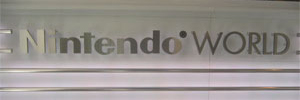
This
summer I got the chance to go to a mini mecca of sorts. I went to the
Nintendo World Store in New York City. Before I go any further, I
must say that my true mecca would probably be the Nintendo world
headquarters in Kyoto, Japan. Anyways, the Nintendo World Store was
previously the Pokemon Center, after some remodeling, the store has
expanded to include all things Nintendo. The location is literally
around the corner from the NBC building that my favorite late night
talk show, Late Night with Conan O’Brien is shot. Since its opening
last May, the Nintendo World Store has sold a few items that are
either only available online or exclusively at the store. Some of
those items include Pokemon Box (Pokemon organization application for
Gamecube), a Zelda themed Game Boy SP, and Electroplankton (music
experience/game for DS). Just last September, Miyamoto himself
visited the store for a signing. Well, enough about the store, let’s
take a look inside…
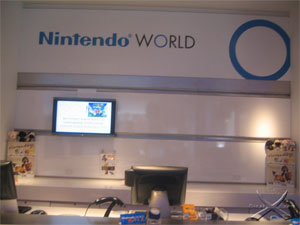
Here’s
a shot of the check out counter. You can’t tell by any of the
pictures I took, but the store is a prety good size, not huge, but it
does have two floors. There are of course, current Nintendo games for
sale. There are also many game demo/station units which you can play
new and upcoming games on. My favorite was a round table with a bunch
of Nintendo DSs.
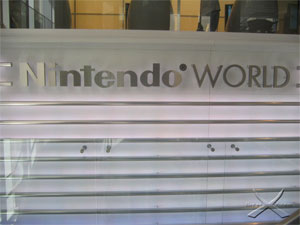
Nintendo
World logo you pass as you walk up the stairs to the second floor.
The second floor contains a small museum of Nintendo products as well
as more demo unit/stations. Let’s take a look at what was on
display…
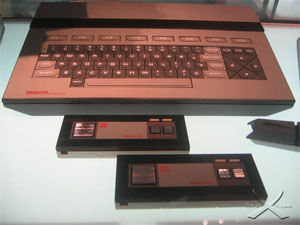
The
Nintendo Advance Video System. This is what the NES could’ve been. If
I’m not mistaken, this was shown at CES in 1985. Minoru Arakawa
(son-in-law of Hiroshi Yamauchi, ex President of Nintendo) showed it
off at the Las Vegas show as the President of Nintendo of America. As
you can see, the controllers do not have the trademark D-Pads the NES
and Famicom are known for. It is also interesting that there is a
QWERTY keyboard.
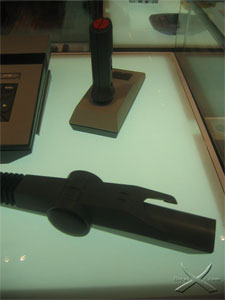
Joystick
and Light Gun for the Advance Video System.
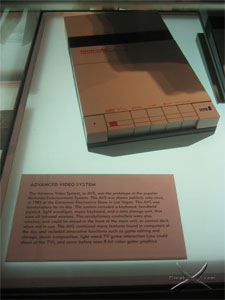
The
Advanced Video System itself.
The
text reads: The Advance Video System, or AVS, was the prototype of
the popular Nintendo Entertainment System. The AVS was shown publicly
only once, in 1985 at the Consumer Electronics Show in Las Vegas. The
AVS was revolutionary for its day. The system included a keyboard,
handheld joystick, light wand/gun, music keyboard, and a data storage
unit, that were all infrared wireless. The revolutionary controllers
were also wireless, and could be stored in the front of the main
unit, or control deck when not in use. The AVS combined many features
found in computers of the day and included innovative functions such
as game editing and storage, music composition, light wand-TV game
interaction (you could shoot at the TV), and never before seen 8-bit
video game graphics.
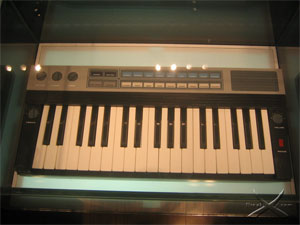
The
Advance Video System music keyboard.
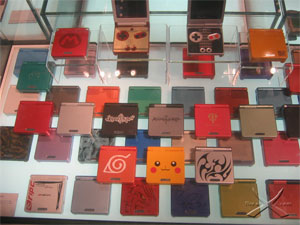
Every
SP that has been released or given away. I own two of these, the NES
themed SP and the second version of the Famicom themed SP.
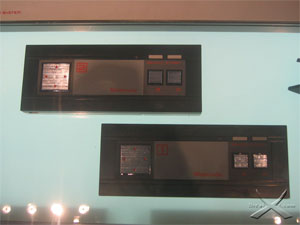
Close
up of the Advance Video System controllers.
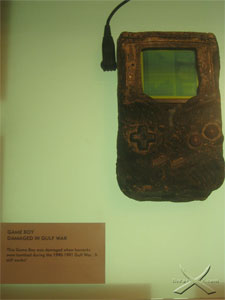
The
text reads: This Game Boy was damaged when barracks were bombed
during the 1990-1991 Gulf War. It still works!
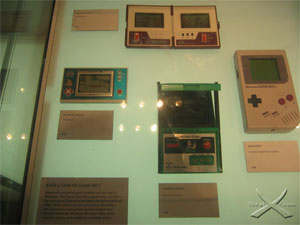
A
few different types of Game & Watch haldheld LCD games and the
original Game Boy with its lovable contrast dial.
The
text reads: EVOLUTION OF GAME BOY: Handheld electronic game systems
are not new to Nintendo. The Game Boy Advance of today can trace its
roots back 25 years to the Game & Watch series of 1980. With each
successive generation Nintendo introduced new innovations and
developed new controls which are the basis for most video game
systems – home and handheld, available today.
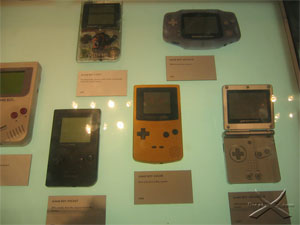
Here
we have the Game Boy Pocket, Game Boy Light (not released in the US,
but you guessed it, a Game Boy with a built in light), Game Boy
Color, Game Boy Advance, and the Game Boy Advance SP.
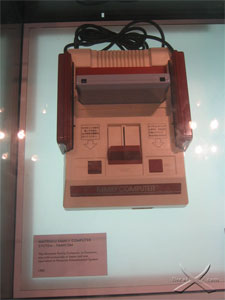
The
Japanese version of what we know as the NES, the Famicom, short for
Family Computer. Both controllers are built into the system and rest
comfortably on the sides of the control deck. Also, if I’m not
mistaken, I think the second player controller has a microphone in
it.
The
text reads: The Nintendo Family Computer, or Famicom, was sold
exclusively in Japan and was equivalent to Nintendo Entertainment
System.
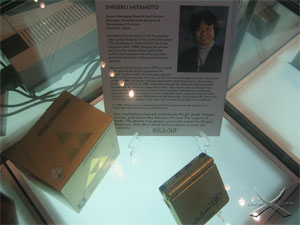
This
is the exclusive Zelda themed Game Boy Advance SP I mentioned
earlier.
The
text reads: SHIGERU MIYAMOTO
Senior
Manager Director and General Manager, Entertainment Analysis &
Development Division, Nintendo, Japan
Considered
by his peers to be the greatest video game designer in the world and
called “The Spielberg of Video Games” by Time magazine (May
1996), Shigeru Miyamoto serves as the creative force behind the
world’s most popular and enduring video games for Nintendo video game
hardware systems.
Miyamoto
joined Nintendo in 1977 as a staff artist and quickly built a
reputation for himself. As the creator of the hugely popular Mario
and Zelda games, he is one of the most revered figures in the video
game world. In 1981, Nintendo released Miyamoto’s first masterpiece,
the arcade game Donkey Kong. In 1985, Nintendo released the Nintendo
Entertainment System with Miyamoto’s Super Mario Bros. The classic
side-scrolling action game set the standard for all future home
console video games. Eventually, more than 40 million units were sold
worldwide, and a series of mega-hit titles was born, including the
1996 Nintendo 64 best seller, Super Mario 64. More than 187 million
video games in the Super Mario series have been sold worldwide.
In
1998, Miyamoto was honored as the first inductee into the Academy of
Interactive Arts and Sciences Hall of Fame.
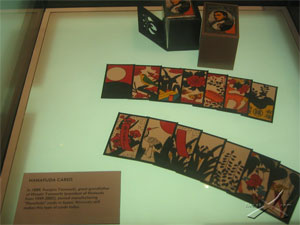
The
text reads: HANAFUDA CARDS
In
1889, Fusajiro Yamauchi, great-grandfather of Hiroshi Yamauchi
(president of Nintendo from 1949-2002), started manufacturing
“Hanafuda” cards in Japan. Nintendo still makes this type of
cards today.
I
wish I could have stayed longer and I definitely should have taken
more pictures. There is a good chance I will be back later this year.
For me, the Nintendo World Store is another reason on a long list of
why New York City is one awesome place.
